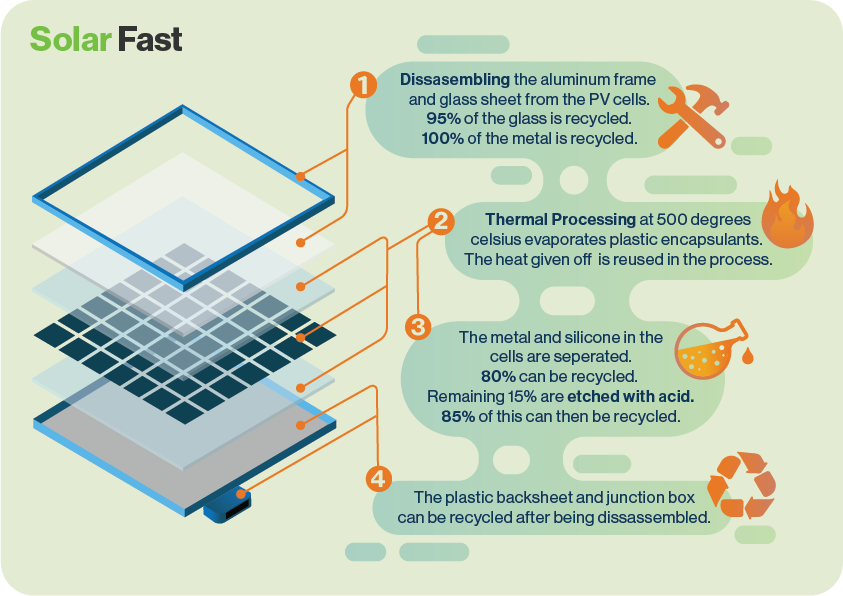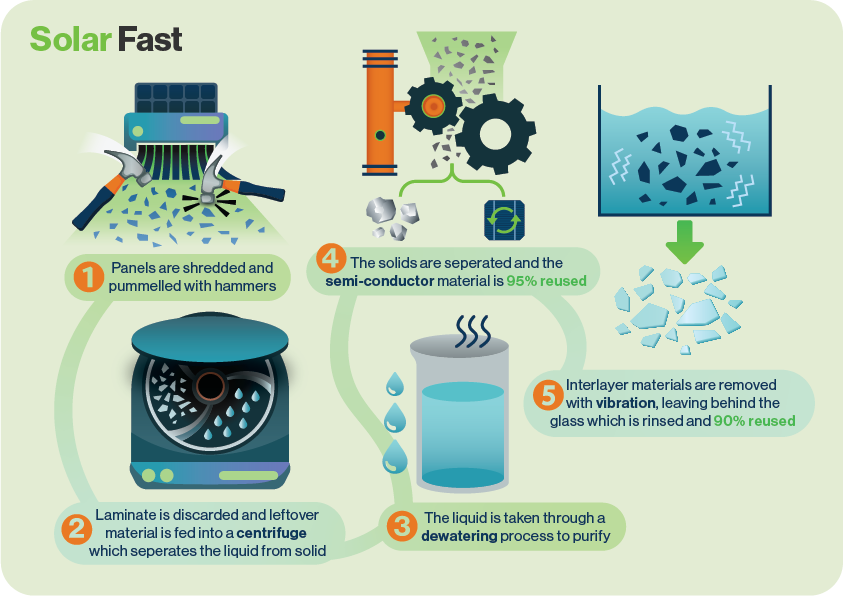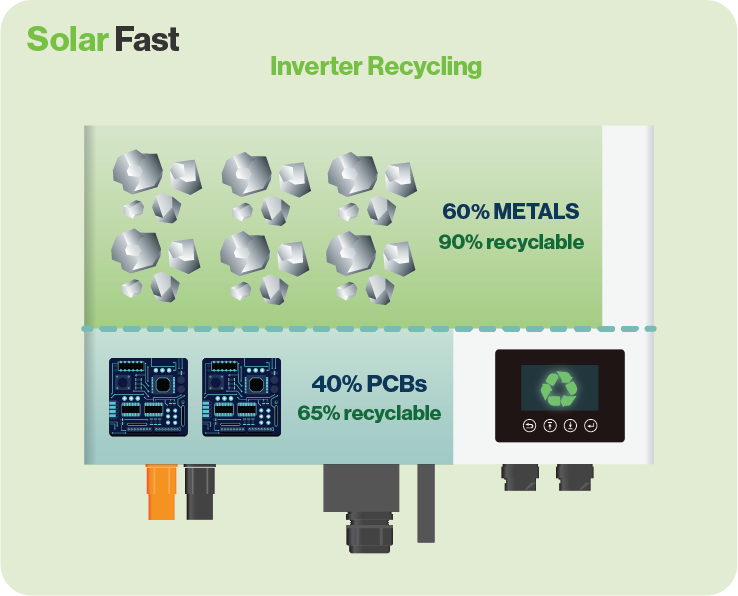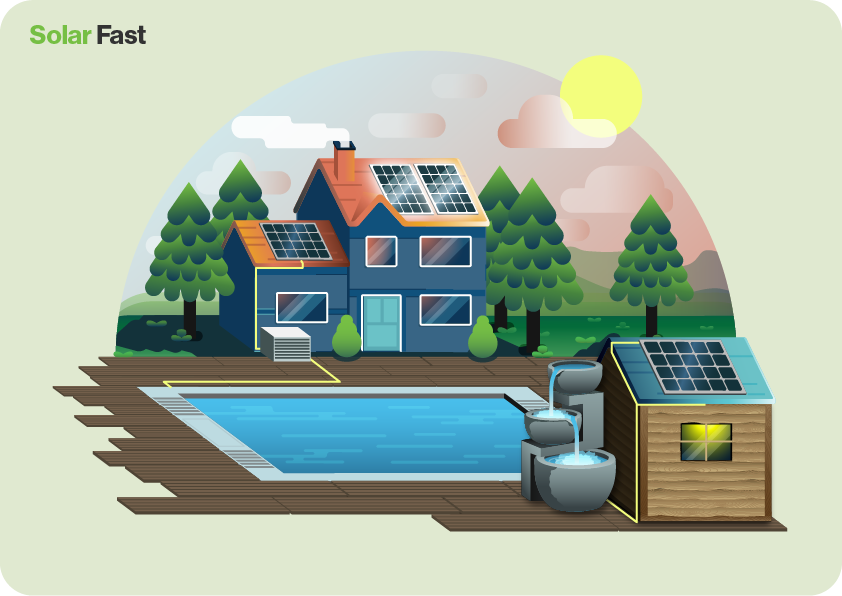The first thing we need to address here is the often-uttered myth that panels and solar energy equipment are not recyclable – this simply isn’t true.
Almost all modern appliances are recyclable to one extent or another, and panels are no exception – they are actually very easy to recycle, but they can be costly and time-consuming.
The myth is easy to perpetuate because the industry is, for all intents and purposes, still in its infancy – meaning the businesses destined to pop up around it are still also in their infancy.
This includes recycling, upcycling, and servicing.
Things are definitely changing though, we are seeing more and more businesses diversifying into solar recycling, servicing and support.
Are silicon-based solar panels recyclable?
Simple answer: Yes
Complicated answer: Yes, but…
And it’s the ‘but’ that causes the confusion.
All the elements of a solar panel are certainly recyclable – metal, glass, plastic and silicon – but it’s the separating of the elements in the photovoltaic cell that causes the most problems.
PV cells are made up of silicon and metal wire, melded together to create the finished article.
When recycling we need to extract the 2 different materials so they can both be used again … and this is not easy.
How are silicon-based solar panels recycled?
Once the panels have been collected, they are then stripped of glass, which makes up around 70% of the item, and 95% of that glass can be recycled, though some is ‘lost’ n the process.
The metal is also removed, just 1% of the panel surprisingly, and 100% of that is reused.
Next is the tricky bit, separating the silicon from the metal and plastic in the PV cell.
The cell is heated to over 500°C which evaporates the plastic coating the cell is sealed with.
The heat from this is actually fed back into the furnace to increase the heat, so even that isn’t wasted.
Once the plastic is gone, the cells can be separated and 85% are simply reused in new PV panels.
The remaining 15% is then ‘etched’ with acid to remove attachments and impurities, again 85% of the materials reclaimed can be used to create new PV Cells.

How are thin-film solar panels recycled?
Thin-film panels are still being used all over the country and are recycled in a much more destructive manner.
Firstly, the panels are shredded, then they are pummelled with hammers until the pieces are no more than 5mm square.
The laminate that holds the panels together is discarded at this stage and the resulting material, both liquid and solid, is fed into a centrifuge – this removes the liquid and retains the solid.
The liquid isn’t wasted though, it’s taken through a dewatering process to purify it.
Solids are treated like metal, and this results in a separation of all the semi-conductors – meaning 95% of that material is reused.
After that, everything is vibrated and rinsed leaving behind only glass.

Other equipment in a solar system that needs recycling
Although the panels are the most talked about part of a solar energy system, and the bit that lasts the longest, there are other appliances that will need recycling.
Inverters
The inverter is the device that converts the DC electricity from the panels into AC electricity for your home – they can also regulate your batteries and feed excess energy to the grid.
In terms of recycling, you can think of an inverter as a PC or similar electronic device as they contain, mostly, printed circuit boards and transformers.
The PCBs are removed and the reusable components are ‘scraped’ off to be used in other equipment.
There are some pretty hazardous components on a circuit board too, so they are removed and disposed of safely.
The PBCs themselves make up 40% of the inverter, and up to 65% of them can be recycled, the rest of the inverter is made up of metals of which 90% can be recycled.

Batteries
The EV market has meant the development of Lithium-Ion batteries has come on in leaps and bounds, facilitating a change in the way we store any energy generated by solar systems.
In the past, energy storage was mostly Lead Acid batteries, similar to the ones you use in your remote control or wireless mouse.
But they are unreliable and difficult to maintain, so Lithium-Ion batteries seem like the perfect replacement.
Unfortunately, there is something of a bottle neck in the recycling of these batteries.
Don’t get us wrong, 95% of a lithium-ion battery can be recycled and used to make new batteries by shredding the battery and dissolving it in special chemicals to separate the elements inside.
This can be environmentally disastrous and quite expensive – but that is changing.
Any emerging industry will result in new start ups that supply everything the industry needs, like recycling, and we are already seeing cheap, effective, safe companies appearing to support the Solar Industry.
Solar Panel Recycling – EU, UK and the US
The EU passed the Waste Electrical and Electronic Equipment Directive (WEEE) in 2012 but it’s really coming into its own now.
Solar panel installers are required to take your used solar panels from you under EU regulations.
The legislation encourages PV panel manufactures to produce more recyclable panels and, also, to offer collection and recycling services of their own, but doesn’t go as far as laying down any laws specific to PV panels.
The industry, to a certain extent, is policing itself and individual countries are passing laws that build on the EU legislation to create a much safer, greener future for all of us.
Anyone with a passing interest in solar energy won’t be surprised to find that Germany leads the EU in solar panel recycling, but they haven’t passed any new laws to strengthen the WEEE.
What they have done is incorporate existing and developing recycling laws to include solar and any other renewable energy equipment.
Here in the UK, the Environmental Agency state that, due to the small amount of toxic material in a PV solar panel, their disposal must fulfil certain legal requirements and standards.
So, despite what the common perception is, you can’t just chuck all your old panels in a skip and forget about them.
UK importers and manufacturers of solar panels must comply with the Producer Compliance Scheme, meaning they must collect, and recycle, panels at the end of their life.
As we said earlier, the EU also have this written into stature, so the UK’s laws are a hangover from our time in that club. Hopefully, the current government won’t throw this on their ‘bonfire of EU law’ as it is also part of our Net Zero commitment.
The US, as a more market-led kind of society, seems to be hoping that the need for panel recycling will match the profit that can be made from it, so they have yet to pass any laws to ban panels from landfill.
There are a few states that are addressing the issue, like California, but until someone learns how to make a huge stack money from recycling solar panels, America will be relying on the good will of installers to ensure equipment is disposed of correctly.
Future Problems in Solar Panel Recycling
There are going to be a few bumps on the road to 100% recycling of solar panels, especially in the United States, but it will sort itself out.
As we say in Yorkshire, “Where there’s muck, there’s brass” or, to translate that into marketing speak, ‘there will always be investment opportunities when it comes to removing other people’s waste products’.
We are experiencing a boom in solar installation as we move towards Net Zero and people become more aware of their energy usage, but the panels and equipment being installed now will not reach the end of their life for another 1 or 2 decades.
In the meantime, recycling companies are popping up everywhere as the technology becomes easier to manage … and the money to be made becomes more obvious.
Upcycling Solar Panels
Solar Panels come with a 25-year guarantee, so you won’t need to be thinking about recycling or disposing of them for a fair while. We offer 30..
However, at the end of the 25th year the panels may very well be in excellent condition, if a bit weather beaten, and will still be functioning at 80% of their original efficiency.
This has already opened a massive market for second-hand panels.
If you have the space, the know-how and the time, you can buy a whole load of old panels and retro fit them for shed lighting, pool warmer or water feature powering.
The truth is, the panels will produce electricity for about 50 or 60, the amount just decreases over time so they are perfectly serviceable for decades.
Learn more about how long solar panels last.








